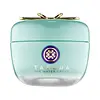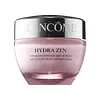What's inside
What's inside
 Key Ingredients
Key Ingredients

 Benefits
Benefits

 Concerns
Concerns

 Ingredients Side-by-side
Ingredients Side-by-side

Water
Skin ConditioningSaccharomyces/Rice Ferment Filtrate
Skin ConditioningDimethicone
EmollientPropanediol
SolventGlycerin
HumectantDiglycerin
HumectantDiphenylsiloxy Phenyl Trimethicone
Skin ConditioningCamellia Sinensis Leaf Extract
AntimicrobialCladosiphon Okamuranus Extract
Skin ConditioningPEG-9 Polydimethylsiloxyethyl Dimethicone
EmulsifyingGold
Cosmetic ColorantBelamcanda Chinensis Root Extract
Skin ConditioningRosa Multiflora Fruit Extract
MaskingHouttuynia Cordata Extract
Skin ConditioningSophora Angustifolia Root Extract
Skin ConditioningSodium Hyaluronate
HumectantLecithin
EmollientPistacia Lentiscus Gum
MaskingSodium Chloride
MaskingSodium Citrate
BufferingMica
Cosmetic ColorantTin Oxide
AbrasiveDimethicone/PEG-10/15 Crosspolymer
Dimethicone/Phenyl Vinyl Dimethicone Crosspolymer
Tocopherol
AntioxidantButylene Glycol
HumectantEthylhexylglycerin
Skin ConditioningDipropylene Glycol
HumectantParfum
MaskingAlcohol
AntimicrobialPhenoxyethanol
PreservativeLimonene
PerfumingLinalool
PerfumingCitral
PerfumingCI 77891
Cosmetic ColorantWater, Saccharomyces/Rice Ferment Filtrate, Dimethicone, Propanediol, Glycerin, Diglycerin, Diphenylsiloxy Phenyl Trimethicone, Camellia Sinensis Leaf Extract, Cladosiphon Okamuranus Extract, PEG-9 Polydimethylsiloxyethyl Dimethicone, Gold, Belamcanda Chinensis Root Extract, Rosa Multiflora Fruit Extract, Houttuynia Cordata Extract, Sophora Angustifolia Root Extract, Sodium Hyaluronate, Lecithin, Pistacia Lentiscus Gum, Sodium Chloride, Sodium Citrate, Mica, Tin Oxide, Dimethicone/PEG-10/15 Crosspolymer, Dimethicone/Phenyl Vinyl Dimethicone Crosspolymer, Tocopherol, Butylene Glycol, Ethylhexylglycerin, Dipropylene Glycol, Parfum, Alcohol, Phenoxyethanol, Limonene, Linalool, Citral, CI 77891
Water
Skin ConditioningGlycerin
HumectantCyclohexasiloxane
EmollientIsononyl Isononanoate
EmollientCaprylic/Capric Triglyceride
MaskingButylene Glycol
HumectantCetyl Alcohol
EmollientStearyl Dimethicone
EmollientGlyceryl Stearate
EmollientStearic Acid
CleansingStearyl Alcohol
EmollientPEG-8 Stearate
EmulsifyingSynthetic Wax
AbrasiveCyclopentasiloxane
EmollientLecithin
EmollientSodium Dextran Sulfate
Gel FormingSodium Chloride
MaskingHydroxypalmitoyl Sphinganine
Skin ConditioningSodium Hyaluronate
HumectantPaeonia Suffruticosa Extract
Skin ConditioningPEG-15 Stearate
EmulsifyingEugenol
PerfumingEthylparaben
PreservativeTriethanolamine
BufferingCrithmum Maritimum Extract
Skin ConditioningPalmitic Acid
EmollientSilica
AbrasiveCellulose Acetate Butyrate
Polyphosphorylcholine Glycol Acrylate
Polycaprolactone
StabilisingPolyvinyl Alcohol
Poloxamer 188
EmulsifyingAmmonium Polyacryloyldimethyl Taurate
Emulsion StabilisingDimethiconol
EmollientLimonene
PerfumingBenzyl Alcohol
Perfuming2-Oleamido-1,3-Octadecanediol
Skin ConditioningCaprylyl Glycol
EmollientAlpha-Isomethyl Ionone
PerfumingMoringa Oleifera Seed Extract
Skin ConditioningCeramide NP
Skin ConditioningDisodium EDTA
Rosa Gallica Flower Extract
AstringentMethylparaben
PreservativeButylphenyl Methylpropional
PerfumingOctyldodecanol
EmollientParfum
MaskingPhenoxyethanol
PreservativeWater, Glycerin, Cyclohexasiloxane, Isononyl Isononanoate, Caprylic/Capric Triglyceride, Butylene Glycol, Cetyl Alcohol, Stearyl Dimethicone, Glyceryl Stearate, Stearic Acid, Stearyl Alcohol, PEG-8 Stearate, Synthetic Wax, Cyclopentasiloxane, Lecithin, Sodium Dextran Sulfate, Sodium Chloride, Hydroxypalmitoyl Sphinganine, Sodium Hyaluronate, Paeonia Suffruticosa Extract, PEG-15 Stearate, Eugenol, Ethylparaben, Triethanolamine, Crithmum Maritimum Extract, Palmitic Acid, Silica, Cellulose Acetate Butyrate, Polyphosphorylcholine Glycol Acrylate, Polycaprolactone, Polyvinyl Alcohol, Poloxamer 188, Ammonium Polyacryloyldimethyl Taurate, Dimethiconol, Limonene, Benzyl Alcohol, 2-Oleamido-1,3-Octadecanediol, Caprylyl Glycol, Alpha-Isomethyl Ionone, Moringa Oleifera Seed Extract, Ceramide NP, Disodium EDTA, Rosa Gallica Flower Extract, Methylparaben, Butylphenyl Methylpropional, Octyldodecanol, Parfum, Phenoxyethanol
 Reviews
Reviews

Ingredients Explained
These ingredients are found in both products.
Ingredients higher up in an ingredient list are typically present in a larger amount.
Butylene Glycol (or BG) is used within cosmetic products for a few different reasons:
Overall, Butylene Glycol is a safe and well-rounded ingredient that works well with other ingredients.
Though this ingredient works well with most skin types, some people with sensitive skin may experience a reaction such as allergic rashes, closed comedones, or itchiness.
Learn more about Butylene GlycolGlycerin is already naturally found in your skin. It helps moisturize and protect your skin.
A study from 2016 found glycerin to be more effective as a humectant than AHAs and hyaluronic acid.
As a humectant, it helps the skin stay hydrated by pulling moisture to your skin. The low molecular weight of glycerin allows it to pull moisture into the deeper layers of your skin.
Hydrated skin improves your skin barrier; Your skin barrier helps protect against irritants and bacteria.
Glycerin has also been found to have antimicrobial and antiviral properties. Due to these properties, glycerin is often used in wound and burn treatments.
In cosmetics, glycerin is usually derived from plants such as soybean or palm. However, it can also be sourced from animals, such as tallow or animal fat.
This ingredient is organic, colorless, odorless, and non-toxic.
Glycerin is the name for this ingredient in American English. British English uses Glycerol/Glycerine.
Learn more about GlycerinLecithin is a term for a group of substances found in the cell membranes of plants, animals, and humans. They are made up of mixture of phospholipids.
This ingredient has emollient and emulsifying properties.
As an emollient, lecithen helps soften the skin and creates a barrier to keep moisture in.
As an emulsifier, it also helps prevent water and oil ingredients from separating. Lecithin can also help ingredients be better absorbed by the skin.
This is because the phospholipids in lecithin produce liposomes. Liposomes help other ingredients get through the skin barrier.
Depending on the source of this ingredient, lecithin may not be fungal acne safe. This is because some sources of lecithin come from soybean oil, which may feed the malassezia yeast that feeds fungal acne.
We recommend reaching out to the brand you are purchasing from to inquire about the source of their lecithin.
Some other names for this ingredient include soy lecithin and deoiled soy lecithin.
Learn more about LecithinLimonene is a fragrance that adds scent and taste to a formulation.
It's found in the peel oil of citrus fruits and other plants such as lavender and eucalyptus. The scent of limonene is generally described as "sweet citrus".
Limonene acts as an antioxidant, meaning it helps neutralize free radicals.
When exposed to air, oxidized limonene may sensitize the skin. Because of this, limonene is often avoided by people with sensitive skin.
The term 'fragrance' is not regulated in many countries. In many cases, it is up to the brand to define this term. For instance, many brands choose to label themselves as "fragrance-free" because they are not using synthetic fragrances. However, their products may still contain ingredients such as essential oils that are considered a fragrance.
Learn more about LimoneneParfum is a catch-all term for an ingredient or more that is used to give a scent to products.
Also called "fragrance", this ingredient can be a blend of hundreds of chemicals or plant oils. This means every product with "fragrance" or "parfum" in the ingredients list is a different mixture.
For instance, Habanolide is a proprietary trade name for a specific aroma chemical. When used as a fragrance ingredient in cosmetics, most aroma chemicals fall under the broad labeling category of “FRAGRANCE” or “PARFUM” according to EU and US regulations.
The term 'parfum' or 'fragrance' is not regulated in many countries. In many cases, it is up to the brand to define this term.
For instance, many brands choose to label themselves as "fragrance-free" because they are not using synthetic fragrances. However, their products may still contain ingredients such as essential oils that are considered a fragrance by INCI standards.
One example is Calendula flower extract. Calendula is an essential oil that still imparts a scent or 'fragrance'.
Depending on the blend, the ingredients in the mixture can cause allergies and sensitivities on the skin. Some ingredients that are known EU allergens include linalool and citronellol.
Parfum can also be used to mask or cover an unpleasant scent.
The bottom line is: not all fragrances/parfum/ingredients are created equally. If you are worried about fragrances, we recommend taking a closer look at an ingredient. And of course, we always recommend speaking with a professional.
Learn more about ParfumPhenoxyethanol is a preservative that has germicide, antimicrobial, and aromatic properties. Studies show that phenoxyethanol can prevent microbial growth. By itself, it has a scent that is similar to that of a rose.
It's often used in formulations along with Caprylyl Glycol to preserve the shelf life of products.
Chances are, you eat sodium chloride every day. Sodium Chloride is also known as table salt.
This ingredient has many purposes in skincare: thickener, emulsifier, and exfoliator.
You'll most likely find this ingredient in cleansers where it is used to create a gel-like texture. As an emulsifier, it also prevents ingredients from separating.
There is much debate on whether this ingredient is comedogenic. The short answer - comedogenic ratings don't tell the whole story. Learn more about comegodenic ratings here.
The concensus about this ingredient causing acne seems to be divided. Research is needed to understand if this ingredient does cause acne.
Scrubs may use salt as the primary exfoliating ingredient.
Learn more about Sodium ChlorideSodium Hyaluronate is hyaluronic acid's salt form. It is commonly derived from the sodium salt of hyaluronic acid.
Like hyaluronic acid, it is great at holding water and acts as a humectant. This makes it a great skin hydrating ingredient.
Sodium Hyaluronate is naturally occurring in our bodies and is mostly found in eye fluid and joints.
These are some other common types of Hyaluronic Acid:
Learn more about Sodium HyaluronateWater. It's the most common cosmetic ingredient of all. You'll usually see it at the top of ingredient lists, meaning that it makes up the largest part of the product.
So why is it so popular? Water most often acts as a solvent - this means that it helps dissolve other ingredients into the formulation.
You'll also recognize water as that liquid we all need to stay alive. If you see this, drink a glass of water. Stay hydrated!
Learn more about Water